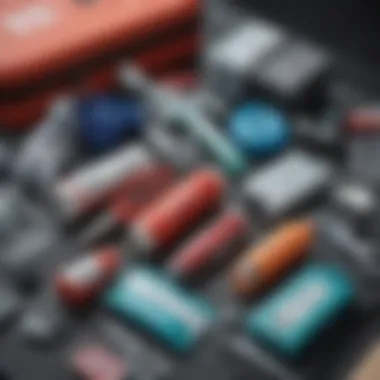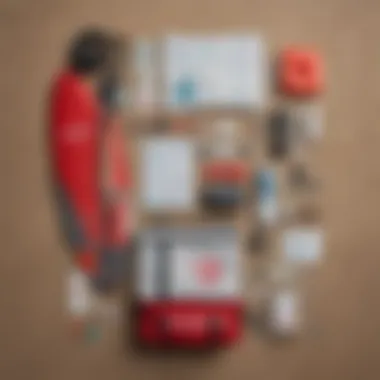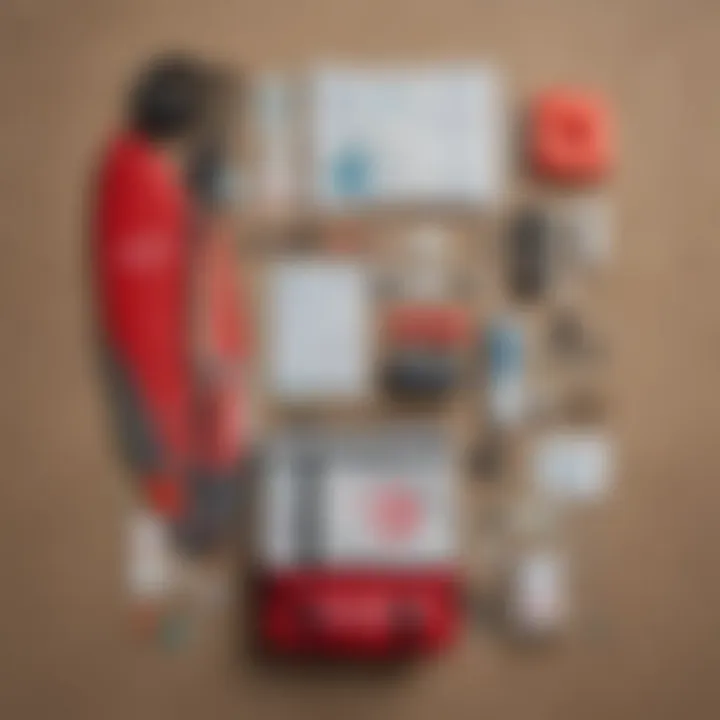Key Elements for a Comprehensive Surf First Aid Kit


Intro
When it comes to surfing, riding the waves is just half the thrill. The other half is being prepared for whatever might happen – injuries, sudden weather changes, or even small emergencies. A surf first aid kit is not just a nice-to-have; it’s a necessity for anyone who spends time in the ocean. Preparing for mishaps isn’t about being anxious or overly cautious; it’s about being smart and responsible. Having the right elements at your fingertips can make a world of difference in ensuring your safety and enjoyment. Let's dive into the key components of assembling a robust surf first aid kit, the necessary gear for different levels of surfers, and practical tips to improve your safety.
Gear Recommendations
A well-stocked first aid kit is one of those things you don’t think about until you need it. Here’s a closer look at what to pack, depending on your surfing experience.
Essential Gear for Beginners
For those who are just wading into the surfing world, simplicity is key. This equipment doesn't need to be heavy-duty for you to feel safe in the water. Here are the essentials:
- Adhesive Bandages: Various sizes for cuts and scrapes. They’re like your best friend after a tumble.
- Gauze Pads: Perfect for more serious injuries. They can be used to control bleeding.
- Antiseptic Wipes: For cleaning wounds; you don't want an infection to crash the party.
- Cold Pack: When you catch a wave but land wrong. They’ll help bring down any swelling.
- Sunscreen: Not exactly first aid in the traditional sense, but protecting your skin can prevent long-term injuries.
Advanced Equipment for Professionals
For those who have been around the block a few times, or are instructors, you might want to beef up your kit a bit:
- Chest Seal: For anyone who might suffer a puncture wound to the torso.
- SAM Splint: Perfect for stabilizing suspected fractures.
- Hemostatic Gauze: This is more advanced but can be lifesaving for severe cuts.
- Emergency Blanket: Helps maintain body temperature in case of shock or hypothermia.
- Triage Tags: Handy for organizing multiple injuries during a larger emergency.
Key takeaway: Having the right gear is just as essential as mastering your technique when it comes to surfing. A well-prepared surf kit can save lives.
Techniques and Tips
Understanding what to do in case of an emergency is as valuable as the gear you have. It’s all about preparation and practice.
Skill Improvement Strategies
In addition to the physical gear, enhancing your skills can prevent injuries altogether. Here are a few suggestions:
- Take Lessons: Learn from experienced instructors who can teach you how to fall safely.
- Practice Ocean Awareness: Knowing the currents and tide patterns can keep you safer.
- Conditioning: Staying fit helps you maneuver better on the board and avoid accidents.
Safety Practices and Guidelines
Finally, incorporating safety into your surf routine is essential:
- Buddy System: Surfing with a friend means someone’s always watching your back.
- Check Your Equipment: Inspect your board and leash regularly to avoid unexpected failures.
- Stay Hydrated: Dehydration can lead to poor decision-making.
Understanding the Importance of a First Aid Kit for Surfers
When you're out riding the waves, the last thing on your mind might be the dangers lurking beneath the surface. However, the fact remains: accidents can happen to even the most seasoned surfers. This is where a well-equipped first aid kit comes into play.
As a surfer, being prepared isn’t just about grabbing your board and heading to the ocean. Every time you paddle out, you’re engaging in an activity that carries certain risks, and understanding these risks is a crucial part of ensuring your safety. A comprehensive first aid kit holds the potential to prevent minor mishaps from escalating into serious complications. It can be the difference between a small injury and something more severe that could cut short your surfing season.
The Risks Associated with Surfing
Surfing, while exhilarating, involves various risks that can’t be simply brushed aside. From cuts and scrapes caused by sharp reefs to bruises from wipeouts, the ocean presents numerous hazards. Even higher-risk scenarios such as collisions with other surfers, equipment failures, or even marine wildlife encounters can happen. Here’s a closer look at some common risks:
- Cuts from Reef: Sharp rocks or coral can easily slice through skin, leading to painful injuries that require immediate attention.
- Bone Injuries: Wipeouts can result in sprained wrists or dislocated shoulders, necessitating swift treatment.
- Dehydration: Spending extended hours in the sun can lead to heat-related conditions. An unknwon scenario can trigger a heat stroke, which is dangerous.
Recognizing these risks ahead of time can help surfers take calculated steps towards mitigating them. But what good are these precautions without the right tools to tackle injuries when they arise?
Why Preparedness Matters
Preparedness is not just a buzzword; it’s a lifesaver. Imagine enjoying a perfect wave, only to find yourself nursing a nasty injury because you weren’t equipped to handle it. When surfing, falling or getting caught off guard can happen in the blink of an eye.
Carrying a first aid kit allows surfers to tackle health issues as they arise, often before they escalate into more serious situations. It is like having a safety net. Some benefits of being prepared include:
- Swift Response: Quick access to medical supplies can minimize further injury.
- Increased Confidence: Knowing you are prepared allows you to push your limits while surfing, knowing help is at hand if you need it.
- Group Safety: If you surf with friends or family, a kit can serve the group’s needs, promoting a culture of safety.


"An ounce of prevention is worth a pound of cure."
Ready to make a first aid kit for your next surfing adventure? Let’s dive into the core components that should be included.
Core Components of a Surf First Aid Kit
Understanding what to include in a surf first aid kit can be the difference between a minor inconvenience and a serious issue. The ocean is playful but can turn on you in a heartbeat. When creating your kit, you want to consider the typical injuries you might encounter and prepare accordingly. Having the right components not only addresses potential accidents but also promotes peace of mind.
The importance of these core components shines through not just in their ability to treat injuries, but also in their role in preventative measures and safe surfing practices.
Adhesive Bandages and Dressings
Adhesive bandages are a staple in any first aid kit, not just for surfers. These handy little pieces of adhesive are designed to cover small cuts and scratches. In the surf, where sharp objects like coral, rocks, and even your board can cause injuries, having various sizes and types of bandages is essential.
- Flexibility: Look for bandages that are waterproof; they provide a barrier against the saltwater, enabling you to stay protected while you continue to enjoy the waves.
- Variety: Include a mix of standard adhesive bandages and larger dressings to handle larger wounds that can occur during wipeouts.
Antiseptic Solutions and Creams
An often overlooked area in first aid is the use of antiseptics. After sustaining a cut or scrape, it’s critical to disinfect the area to prevent infection. The ocean is full of bacteria, and while you might think saltwater cleanses, it can also introduce harmful germs.
- Choices: Preparing your kit with various antiseptic solutions, like hydrogen peroxide or iodine, is wise. You may also consider antiseptic creams that soothe and heal at the same time.
- Easy Application: Small, single-use packets of antiseptic wipes can be easier to use on-the-go rather than dealing with a large bottle in a sandy environment.
Gauze Pads and Tape
When facing more significant injuries like gashes or lacerations, adhesive bandages might not cut it—pun intended. This is where gauze pads and medical tape come into play.
- Protection: Gauze pads can absorb excess blood and protect open wounds. Having various sizes is important depending on the severity of the injury.
- Tape: Medical tape is essential as it holds the gauze in place. Look for breathable options that are gentle on the skin but secure.
Pain Relievers and Anti-Inflammatories
Surfing can take a toll on your body, and you might find yourself in need of pain relief. It’s essential to include both over-the-counter pain relievers and anti-inflammatories in your kit.
- Types: Non-steroidal anti-inflammatory drugs (NSAIDs) like ibuprofen can address inflammation and pain, while acetaminophen works for general discomfort. It’s ideal to have both types handy.
- Dosage: Always remember to include proper dosage instructions for self-administration or hand off to someone else if necessary.
Cold Packs and Heat Packs
The right temperature treatment can make a world of difference post-surfing. Cold packs help with swelling and pain right after a fall, while heat packs are beneficial for stiffness or cramps after an extended period in the water.
- Types of Packs: You might want to stock up on instant cold packs that don’t need a freezer. They’re compact and easy to toss in your bag.
- Warmth on Demand: Reusable heat pads are equally important for those days when you've been paddling hard and your muscles need some TLC.
Having these core components in your surf first aid kit equips you for the unexpected. The ocean is marvelous, yet unpredictable, making your preparation not just sensible but essential. Enlightening yourself on the tools necessary to handle common mishaps paves the way for safer and more enjoyable adventures in the surf.
Addressing Common Surfing Injuries
Understanding how to deal with injuries that commonly occur in surfing is crucial. Surfers, of all skill levels, can face a variety of accidents and mishaps in the water. From minor abrasions to more serious injuries, knowing how to address these situations can make a significant difference in recovery and ongoing enjoyment of the sport. The right first aid kit, supplemented with knowledge about effective first aid practices, can ease the immediate aftermath of these injuries and possibly prevent further complications.
Cuts and Scrapes
Cuts and scrapes are nearly as common as surfboards in the ocean. Whether caused by sharp coral, rocks, or a wipeout, these injuries can vary from minor to quite severe. A basic understanding of how to clean and dress cuts is essential for surfers.
- Immediate care is key. Cleaning the wound promptly with clean water and, if available, an antiseptic solution can prevent infection.
- Adhesive bandages should be included in the first aid kit for superficial cuts, while larger scrapes might require gauze and tape to protect the area.
- Don't forget to keep an eye on the wound post-treatment. If redness or swelling occurs, it could indicate an infection.
Sprains and Strains
Sprains and strains can often be overlooked until they become problematic. These injuries usually occur during improper falls or when pushing one’s limits while surfing. The symptoms can sometimes go unnoticed until the pain sets in after the session.
- Rest and elevation can work wonders. Use cold packs from the first aid kit to reduce swelling.
- Compression wraps can also help stabilize the injured area. Ensuring that the injury is not overexerted in the days following can be crucial for a speedy recovery.
- Regardless of severity, if there is a significant amount of pain or difficulty moving the area post-injury, seeking a professional opinion might be necessary.
Lacerations from Equipment


Lacerations resulting from surfboard fins or other equipment are particularly concerning. These injuries can lead to deep cuts requiring stitches, all while being prone to bacteria from the ocean.
- First things first, control the bleeding. Applying pressure with a clean cloth or gauze can help manage this.
- If the cut is deep and the edges are not meeting, it is essential to visit a medical professional. The risk of deep infections is high, and only a doctor can ensure proper treatment.
- Antiseptic treatment post-injury is vital to reduce the chances of infection. Healing those lacerations properly is paramount, as the ocean can easily worsen the situation if not addressed promptly.
Sunburn and Skin Irritations
Lastly, sunburn is another top contender on the list of common golfing injuries. Prolonged exposure to the sun can lead to severe skin problems, even when you're just trying to catch some waves.
- Prevention is in your hands. Using a high-SPF, water-resistant sunscreen before heading out is the best first step. However, if damage occurs, after-sun lotions with aloe vera can soothe the affected areas.
- If you find your skin irritated, it’s wise to hydrate and avoid further sun exposure until the skin has healed.
- Keep an eye on any unusual spots. While sunburn can typically be managed at home, any unprecedented discoloration should be checked by a healthcare professional for safety.
"A well-organized first aid kit is not just a suggestion; it's a necessity for anyone hitting the waves. Knowing how to effectively use it can keep a minor issue from becoming a major setback."
By understanding and addressing these common injuries effectively, surfers can minimize their impact on future outings and ensure that their love for the sport remains unscathed.
Specific Considerations for Marine Environment
Surfing comes with its own set of unique challenges. In the vast blue ocean, not only do surfers need to be ready for potential injuries from wipes outs or the equipment, but they must also be on guard against issues specific to the marine environment. The right first aid kit isn't just a collection of random items—it’s a thoughtfully designed survival resource. By understanding these considerations, surfers can navigate emergencies with a level head, ensuring safety in and out of the water.
Dealing with Marine Life Stings
Marine creatures can pack a punch, sometimes literally. In the surf, encounters with jellyfish, sea urchins, or stingrays can happen faster than a surfer can ride a wave. Knowing how to deal with these stings is essential. If you or someone else gets stung:
- Stay Calm: Panic can worsen the situation. Keeping a cool head helps in managing pain and making sound decisions.
- Remove Yourself from Water: If possible, get to shore. This prevents further encounters with marine life.
- Rinse with Vinegar: For jellyfish stings, rinsing the area with vinegar can help neutralize the venom. Don’t rinse with fresh water as it can irritate the wounds more.
- Use a Hot Water Soak: Immersing the sting site in hot water (as hot as the person can tolerate) for 20-45 minutes can ease pain by breaking down toxins.
It’s prudent to have a few resources available in your first aid kit specifically for these incidents. A pair of tweezers for removing barbs or spines, a pack of vinegar, and antiseptics will help treat the wound effectively. Remember, being prepared means you're less likely to be caught napping should an unexpected sting occur.
Hypothermia and Heat Exhaustion
Surfers can also face the dual dangers of being too hot or too cold, which can sneak up on you unexpectedly. Hypothermia doesn’t only happen in freezing water; it can also occur in cooler temperatures when wet. Conversely, if the sun is blasting down, heat exhaustion can hit like a bolt from the blue.
- Hypothermia Symptoms: Shivering, confusion, fatigue. It’s essential to get the person out of the water, wrap them in dry, warm blankets, and offer warm, non-alcoholic beverages. Heat loss is rapid in wet conditions, so keeping warm should be the top priority.
- Heat Exhaustion Signs: Headaches, dizziness, and nausea signal overheating. Move to a shaded area, hydrate with cool water, and remove excess clothing to cool off.
Having temperature regulation items in your first aid kit can make all the difference. Consider including insulating emergency blankets, electrolyte replacement drinks, and a thermometer.
Remember: Staying aware of weather conditions and having a plan in place can keep you one step ahead of these potentially dangerous situations.
Emphasizing these specifics not only enhances safety but also reassures surfers that they are prepared to face the unpredictable nature of the ocean. A well-stocked kit tailored to marine situations means you can enjoy surfing while also looking after your health.
Customizing Your Surf First Aid Kit
Customizing your surf first aid kit isn’t just a good idea; it’s a must. Every surfer has unique needs depending on their health, location, and the specific hazards they face while catching waves. A well-equipped surf first aid kit can mean the difference between a minor annoyance and a serious issue when injuries occur or unexpected health problems arise. By fine-tuning your kit to suit your circumstances, you’re not just preparing for the knowns; you’re also ready for the curveballs that nature may throw your way.
Tailoring your kit can also ensure that you have quick access to specific items that address your personal and local conditions, making it a critical part of your surf gear.
Personal and Local Considerations
When it comes to building your surf first aid kit, personal and environmental factors play a significant role. Consider the following:
- Health Conditions: Do you have any pre-existing health issues or allergies? For instance, if you have a known allergy to bee stings or certain medications, including an EpiPen or an alternative remedy is crucial.
- Local Environment: If you're surfing in an area known for its jellyfish, having a vinegar solution might be prudent. Similarly, beaches with rocky shores present an entirely different set of risks than those with smooth sands.
- Weather Conditions: Local climate affects what injuries might be more prevalent. High temperatures can lead to heat exhaustion, therefore including electrolytes and hydration solutions may be essential.
- Behavioral Considerations: Are you a beginner or a seasoned surfer? Beginners might want to keep extra resources for common first-aid situations, while more experienced surfers may prioritize advanced equipment for severe injuries.
By incorporating local and personal considerations, your surf first aid kit becomes a tailored companion, ready to assist no matter what happens.
Adding Personal Medications
Next, let’s discuss the aspect of adding personal medications—a crucial step that's often overlooked. This goes beyond basic over-the-counter pain relievers. Here’s what you should think about:
- Regular Medications: If you are on medication for chronic conditions like asthma or hypertension, keeping a spare supply in your kit is wise.
- Emergency Medications: Those who suffer from severe allergies should also include antihistamines, just in case they encounter something unexpected while at the beach.
- Travel Considerations: If you’re traveling to surf different locales, research the availability of your medications and any potential issues with customs. Bringing what you need ensures you won’t be caught off guard in a remote location.
- Dosage Information: Alongside personal medications, it may also help to include a brief note detailing dosages and conditions for which they’re taken. This could assist anyone providing aid if needed.
Incorporating personal medications not only adds a layer of preparation; it reflects a proactive approach to safety that every responsible surfer should adopt.


Maintaining Your First Aid Kit
A surf first aid kit is not just a collection of items shoved into a bag; it represents a commitment to safety and readiness for the unexpected while you're out riding those waves. However, having the right items is only part of the equation. Regular maintenance of this essential kit takes it a step further, ensuring that everything remains effective and reliable when you need it most. It's a bit like keeping your surfboard in top shape—neglect it, and you're looking at trouble when you hit the water.
Regular Inventory Checks
Regular inventory checks are a must for every surfer’s first aid kit. This means routinely sifting through the contents, a task that might seem mundane, but it holds significant importance. Why? Because items can sneakily disappear, and some may not be where you left them. Picture yourself at the beach with a nasty cut; it's the last moment you want to realize your antiseptic wipes have vanished like a wave receding from the shore.
Consider scheduling these checks. You could align them with your surf sessions, setting aside a bit of time each month to ensure everything is in order. Here’s a quick checklist:
- Count the number of adhesive bandages.
- Check if you have enough gauze pads.
- Ensure that your antiseptic solutions are not too low.
- Look out for any items that may be damaged or were used up during your last adventure.
Remember, this proactive step can save you from significant headaches later on. You wouldn’t want to be caught off guard by simply not having the right tools at hand.
Expiration Dates and Replenishment
Expiration dates—those little numbers can often be overlooked, but they are crucial in maintaining the efficacy of your first aid kit. Just like milk in your fridge, the supplies in your kit have a shelf life. Using expired items, especially medications or creams, can lead to ineffective treatment when you're in a jam.
It’s wise to set reminders to check expiration dates every few months. Here's how to manage it cohesively:
- Label Items: Put a small label on medicines and antiseptics with their expiration dates; this helps you keep track at a glance.
- Replace Promptly: When you notice something approaching its expiration, make it a priority to replace it.
- Write Down a List: Keep a log of what’s needed for replenishment in your kit. It can be a simple notebook or even a note on your phone.
By following these practices, you ensure that your surf first aid kit is not just a box of items, but rather a functional tool ready to address injuries as they arise. As you navigate the waters, remember that preparedness is a key component of enjoying the experience safely.
"Safety is not a gadget but a state of mind."
In the end, maintaining your first aid kit isn't just about checking boxes—it's a critical aspect of being a responsible and prepared surfer, allowing you to ride the waves with confidence.
Best Practices for Using a First Aid Kit in Emergencies
In the unpredictable world of surfing, accidents can happen in the blink of an eye. It’s essential for surfers to know how to effectively use their first aid kit when emergencies arise. This section focuses on key practices that can make a real difference in the heat of the moment. Being prepared isn't just about having the right supplies; it's equally crucial to know how to respond swiftly and appropriately to injuries and accidents.
Assessing the Situation
When faced with an emergency, the very first step is to assess the situation. Take a moment to gather your thoughts and observe what's happening. Is the incident being caused by a fellow surfer? Is the injury severe, or can it be managed on-site? Here are some points to keep in mind:
- Evaluate safety first: Ensure the area is safe for both yourself and the injured person. Is the water calm? Are potential hazards, like rocks or other surfers, nearby?
- Determine the severity: Look at the injury closely. Is there heavy bleeding or signs of shock? Understanding the level of urgency can affect your approach.
- Stay calm: Your demeanor can influence how others react. Keeping a cool head helps in making better decisions.
Remember that in this chaotic environment, a calm response can set the tone for how the rest of the situation unfolds. Always structure your assessment based on the clearest details available. Listen to the injured party if they can communicate; they often provide valuable insight into their condition.
Performing Basic First Aid
Once you’ve assessed the situation and established that it’s safe for you to proceed, you can move on to performing basic first aid. This is where your surf first aid kit's contents come into play. Each component serves a purpose that, when applied correctly, can aid recovery. Here are some key steps to follow, tailored for common surfing injuries:
- Control bleeding: If there’s a cut, apply pressure with a clean gauze pad or an adhesive dressing. If blood seeps through, do not remove the first layer; rather, add more on top.
- Clean the wound: Use an antiseptic solution to clean around the area, avoiding any further irritation to the injury itself.
- Dress the area: After ensuring it’s clean, cover the wound with the appropriate dressing. Make sure it’s secure but not too tight to impede circulation.
- Monitor the injured surfer: Keep an eye on their condition. Look for signs of shock, confusion, or anyone struggling to breathe.
- Seek further help if necessary: If the situation looks dire, don’t hesitate to call for professional assistance.
"In the chaos following an injury, your ability to remain collected and focused can prove invaluable—not just for providing care, but for instilling a sense of safety in others."
By honing these basic skills and understanding the contents of your surf first aid kit, you become better equipped to handle emergencies effectively. Whether you’re in the water or on the beach, knowing what to do can make all the difference.
Epilogue: Emphasizing Safety in Surfing
In the world of surfing, the exhilaration and thrill that comes with riding the waves often overshadows the inherent risks associated with the sport. However, prioritizing safety through proper preparation can significantly enhance the enjoyment and reduce the likelihood of injuries. Building a well-stocked surf first aid kit is not just a smart decision; it's essential for surfers of all levels.
The essence of safety in surfing centers around being ready to tackle unforeseen incidents. Whether it’s a nasty cut from a surfboard fin, a sting from a jellyfish, or a twisted ankle from an unfamiliar break, having the right gear can make a world of difference.
Consider this: when you're thousands of miles from the shore, a robust first aid kit becomes your lifeline. It’s not merely about containing band-aids and ointments; it’s about having the know-how to utilize those supplies effectively under pressure. Each component in your kit should have a purpose, whether that’s to treat sunburn or to manage a sprained wrist. Planning for these scenarios can help you react calmly and efficiently when the tide turns for the worse.
Equipping yourself in advance reflects a commitment to your well-being and that of your surfing companions. Other surfers on the beach or in the lineup may rely on someone having the necessary supplies when emergencies arise.
Here are key benefits of maintaining a comprehensive surf first aid kit:
- Preparation for Common Injuries: Surfers frequently encounter specific injuries, such as lacerations and abrasions. Having the right supplies ensures that these can be managed swiftly.
- Boosting Confidence: Knowing that you are well-equipped can help you focus more on the waves rather than worrying about potential injuries.
- Promoting Team Safety: If you're with friends, having extra supplies means you can assist others when needed, fostering a safer surfing environment.
As we conclude, it's clear that embracing a safety-first mindset in surfing is not just about personal health; it's also about enhancing the entire experience for yourself and your fellow surfers. A surf first aid kit, when paired with knowledge and preparedness, empowers surfers to navigate both the waves and the unforeseen events that may come with them. Next time you're gearing up for your ocean adventure, take a moment to check your kit; it's one of the best investments you can make for your surfing journey.
"An ounce of prevention is worth a pound of cure." - Benjamin Franklin, and in surfing, this couldn't be more accurate.















